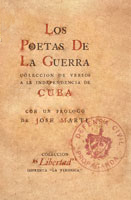3.1.7 In the heat of battle, recurrence of the war theme in Cuban poetry between 1868 and 1898

At first glance, one might assume that poetry with a war theme is somewhat limited by its very political intent; however, it encompasses a broad spectrum that, while issuing a call to combat, also rebels against Spain, against betrayal, and includes the melancholic song of the emigrant and the evocation of love from the wilderness and the devastation of death. Many poems of this nature were collected in “The Poets of War,” published by José Martí in 1893.
Roberto Manzano’s metapoetic inspiration offers the following description: “Verse helped in the jungle to survive, to unite wills, to clarify strategies, to compensate for losses, to stimulate triumphs, to bandage wounds, to resurrect the dead. Three Cubans under a branch, and already the verse grew from their lips, pushed by the tanned hands of the machete. (…) The verse represented everything when Cuba spilled out into the open air to plant its newly embroidered flag in the wind.”
The most important text in terms of its symbolic fusion of the nation’s poetic and patriotic trajectory, beyond its purely literary values, is undoubtedly the Bayamo Anthem, which tradition says was composed by Perucho Figueredo on horseback, perhaps real, perhaps metaphorical, alluding to the indissoluble link woven between poetry and combat action, whether the verse was a reflection or an unavoidable call to battle.
Less well-known, but filled with the same resounding clarion echoes, is Enrique Loynaz del Castillo’s “Invasor Hymn,” itself associated with the patriotic endeavor of the Invasion of the West, which allowed for the symbolic consolidation of nationality by breaking the regionalism that had so hampered the independence drive, and which found numerous expressions in poetry. Some stanzas from this song are reproduced:
“To the Villas, Cuban patriots,
That duty calls us to the West…
Throw the tyrant out of the homeland
You must die or win…
(…)
The adored memory of Martí
Our lives an offering to honor…
And the bright sword guides us
From Maceo to the invading advance.
(…)
From the West the active campaign
Everywhere it casts impetuous brilliance…
That the soldier of Spain cannot
Equal the Cuban in value.
At a gallop, squadrons, let us march
That the bugle ordered to cut the throat,
Let us raise the furious machetes,
Death to the vile man who outraged the country”
The machete, the quintessential symbol of the “armed” struggle undertaken by Cubans, was praised in diverse verses. Enrique Hernández Miyares and Francisco Sellén are especially noteworthy in this regard; however, many of those who took up the pen wielded the machete with greater vigor, and their poetic value is recognized as tangential, even if they did not achieve a high aesthetic achievement.
From this perspective, the verses of the Father of the Cuban Homeland, Carlos Manuel de Céspedes, who is the author of the sonnet entitled “The Traitors,” can be reflected, in which he laments the apathy, or rather apostasy, of some who also called themselves Cubans: “It is not possible, by God!, that they are Cubans / Those who, dragging impious servitude / Go to the dance, to the fence and to the orgy / Insulting the pain of their brothers.”
An important note for Cuban identity within this framework is Diego Vicente Tejera’s poem entitled “Cubans, Union!” undoubtedly reminiscent of the slogan “Workers of the world, unite!” expressed by Karl Marx and Friedrich Engels in the Communist Manifesto, which reflects a priority need for any national project: “Unity is strength. United we shall have / Honor, homeland, glory, liberty, power. / But alas! If amid the clash of infamous parties / Cuba’s grievance is lost!”








